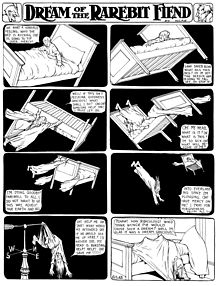Dream of a Rarebit Fiend (film)
| Dream of a Rarebit Fiend | |
|---|---|
Dream of a Rarebit Fiend | |
| Directed by | Wallace McCutcheon Edwin S. Porter |
| Written by | Winsor McCay (comic strip) |
| Starring | Jack Brawn |
| Cinematography | Edwin S. Porter |
| Distributed by | Edison Manufacturing Company |
Release date |
|
Running time | 6 minutes |
| Country | United States |
| Language | Silent |
Dream of a Rarebit Fiend is a 1906
In 2015, the United States Library of Congress selected the film for preservation in the National Film Registry, finding it "culturally, historically, or aesthetically significant".[3][4]
Plot
The Rarebit Fiend gorges on Welsh rarebit at a restaurant. When he leaves, he begins to get dizzy as he starts to hallucinate. He desperately tries to hang onto a lamppost as the world spins all around him. A man helps him get home. He falls into bed and begins having more hallucinatory dreams.
During a dream sequence, the furniture begins moving around the room. Imps emerge from a floating Welsh rarebit container and begin poking his head as he sleeps. His bed then begins dancing and spinning wildly around the room before flying out the window with the Fiend in it.
The bed floats across the city as the Fiend floats up and off the bed. He hangs off the back and eventually gets caught on a
Production and release

The Fiend was played by John P. "Jack" Brawn.
The Edison Military Band performed a piece called "Dream of the Rarebit Fiend" on an
See also
References
- ISBN 978-0520009479
- ISBN 9780520060807
- ^ Mike Barnes (December 16, 2015). "'Ghostbusters,' 'Top Gun,' 'Shawshank' Enter National Film Registry". The Hollywood Reporter. Retrieved December 16, 2015.
- ^ "Complete National Film Registry Listing". Library of Congress. Retrieved 2020-06-09.
- ^ Dover editors 1973, p. xiii.
- ^ Goldmark 2007, p. 227.
Works cited
- Dover editors (1973). Dreams of the Rarebit Fiend. ISBN 978-0-486-21347-7.)
{{cite book}}:|author=has generic name (help)CS1 maint: ref duplicates default (link - Goldmark, Daniel (2007). "Before Willie: Reconstructing Music and the Animated Cartoon of the 1920s". In Goldmark, Daniel; Kramer, Lawrence (eds.). Beyond the Soundtrack: Representing Music in Cinema. ISBN 978-0-520-25070-3.
External links
- Dream of a Rarebit Fiend essay by Lauren Rabinovitz at National Film Registry [1]
- Dream of a Rarebit Fiend at IMDb
- Dream of a Rarebit Fiend on YouTube

